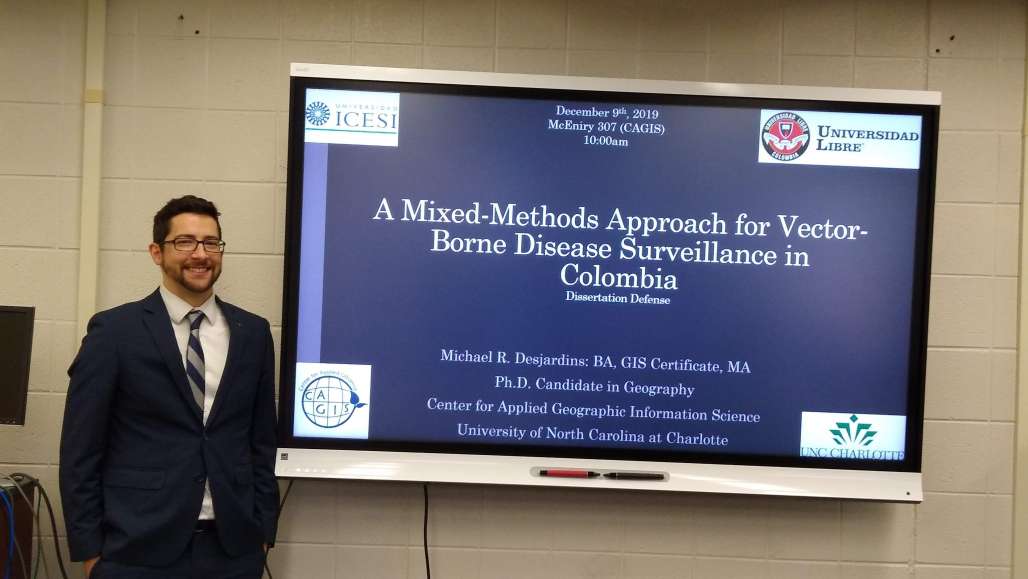Geography Alumnus on Frontlines of COVID-19 Research

Yes, geographers can be heroes.
Keene State 2014 graduate Michael R. Desjardins is at the forefront of studying COVID-19 using geographical methods. In December, Michael earned his PhD in geography, specializing in medical geography and spatial epidemiology from the University of North Carolina at Charlotte.
Now, as a post-doctoral fellow in the Johns Hopkins Bloomberg School of Public Health’s department of epidemiology, he is lead author of what is thought to be the first scholarly article published on using spatial science techniques to study the initial outbreak of the novel coronavirus.
Using Johns Hopkins’ data on confirmed cases, which is updated daily on the Johns Hopkins COVID-19 dashboard, Michael and his coauthors verified eight clusters first reported in the news through mid-March, including in Seattle, New York’s Westchester County, and counties in Louisiana and Florida. Then, they identified 26 clusters using a couple of weeks of updated data, and showed that in New York, the five boroughs of New York City were the new hotspots.
The Johns Hopkins Center for Systems Science and Engineering data is publicly available, so researchers and public health departments can now use the model Michael established to track and predict clusters of COVID-19.
“I’m a medical geographer by training,” says Michael, “and yet, everything that we do has a geographic outcome. So our location will influence our health outcomes, our risk, our exposures – everything. Geographers are well positioned to study COVID-19, and really, any disease. Transportation geography, economic geography – all these different domains and subdomains in geography can contribute to studying public health outcomes.”
That includes disproportionate outcomes, he says – meaning economic and social impacts, among others, play a role in who is infected and who is more adversely affected by an illness like COVID-19.
Michael and his colleagues at the Spatial Science for Public Health Center, which is based at the Johns Hopkins Bloomberg School of Public Health, are now busy with a few projects that look at the efficacy of social distancing in flattening the curve of the pandemic. How many cases are undetected? How should testing be allocated, and what kinds of interventions will best mitigate the spread of the disease?
“People are asking, ‘How much longer should I stay at home?’” Michael says. “What is the threshold? How many weeks or months of social distancing do we need to not just flatten the curve, but reach an exponential decrease so we know for sure it’s safe to gradually open counties and states?”
Michael came to Johns Hopkins to study food borne illness from a geographic perspective; specifically, he was looking at a type of bacteria found in shellfish (Vibrio Parahaemolyticus) in the Chesapeake Bay watershed. But since COVID-19 emerged, “it’s been all hands on deck,” he says. “My postdoc got turned upside down, but it’s nice to contribute to fighting the pandemic – though it’s also very exhausting.”
Back at Keene State, Michael specialized in GIS – geographic information systems – and worked with Professor Chris Brehme. He credits Brehme and two other college mentors, biology professors Karen Cangialosi and Scott Strong, with setting him on a path that led to his postdoctoral fellowship at the top university for public health in the country.
Through one of Keene State’s SURF grants – aka Student Undergraduate Research Fellowship – he traveled to the Turks and Caicos Islands to study coral reefs with Cangialosi and Strong, using geography techniques to look at conservation of coral reef ecosystems. “That was a really amazing experience,” he says. “It changed my life in terms of pushing for more integrated science and mixed methods.”
His time at Keene State still counts as the best four years of his life, Michael says. When he goes to conferences, he tells people that Keene has one of the best undergraduate geography programs in the country. His geography major classmates all have good jobs in the field or have gone on to graduate school. The program really prepared him for entering a master’s program and for writing a master’s thesis, he says, and Chris Brehme was influential in helping him gain admission to the UNC-Charlotte program.
Couple that with the beauty of the campus and the downtown Keene location, and Keene State is “a perfect place to go to school, in my opinion,” says Michael – who is starting out on a career path that he hopes includes both teaching and research. For now, that means using the tools of a geographer to work to keep people safe in a pandemic.





